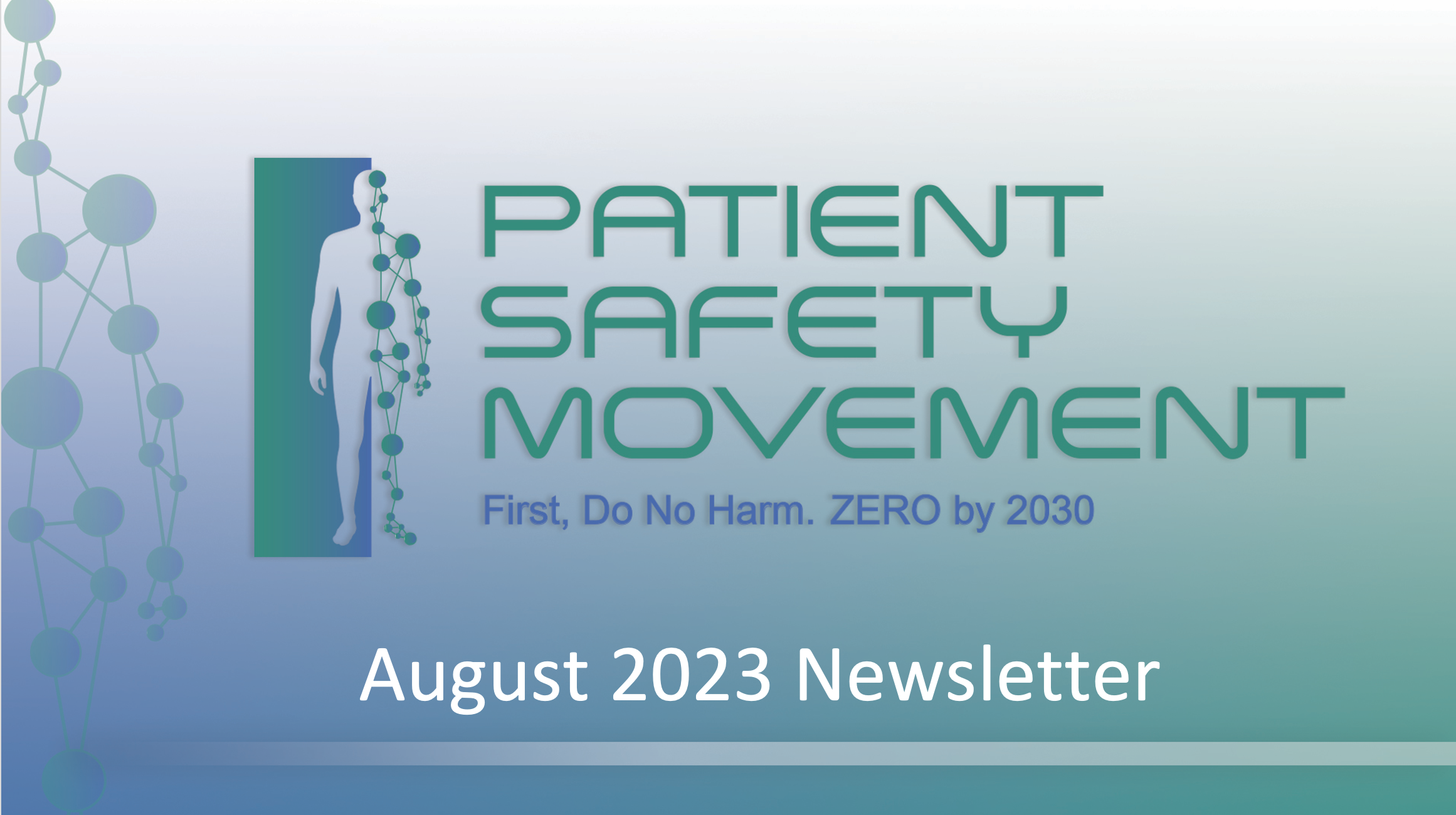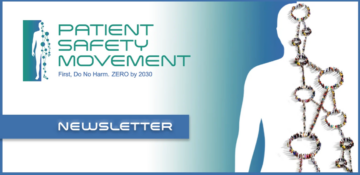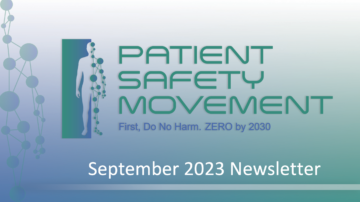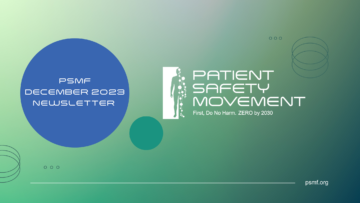Letter from CEO

The last two months have seen some profound presentations, publications, and recommendations to improve patient safety in the US and globally. We have had a Summit meeting in Newport Beach with so many passionate world-renowned speakers on patient safety. Our founder, Joe Kiani, demanded that we call people
in office at the local, state, and federal levels to hardwire patient safety; and align incentives so that every hospital puts in place actionable evidence-based incentives. Peter Pronovost urged that people stop believing that harm in healthcare is inevitable and start believing that it is entirely preventable. We can get to zero harm, zero physical harm, zero suffering, and zero inequities. Anthony Staines emphasized that patient safety must be a global priority that requires urgent action from countries, institutions, and providers. Sanaz Massoumi eloquently stated that we already know how to get to zero—First, Do No Harm!
Don Berwick reminded us that excellence is not an accident; it is the consequence of intentional leadership. He then gave an inspiring keynote address on patient safety with the theme of “If I Was President!” Jannicke Mellin-Olsen said that a guiding principle is to promote respect, dignity, compassion, and love in all action plan behavior—how bold is that? Mike Durkin clearly articulated that we need our Patient Safety Movement Foundation to be a global family.
The two-day meeting was inspiring, and I feel that we will see much improvement in patient safety in the next few years, especially if we all come together with the same goals.
Then at the end of last month, the President’s Council of Advisors in Science and Technology published what its subgroup on patient safety had proposed to President Biden. The co-leads were Joe Kiani and Eric Horvitz and PCAST members Lisa Cooper and Sue Desmond-Hellmann. The external members were Don Berwick, Christopher Hart, Harlan Krumholz, Julie Morath, Peter Pronovost, and Sue Sheridan. Their conclusions and recommendations were that despite stunning advances in medical science, we still have important gaps in patient safety.
Recommendations:
1A: Appoint a Patient Safety Coordinator reporting to the President on efforts to transform patient safety among all relevant government agencies.
1B: Establish a multidisciplinary National Patient Safety Team (NPST) and ensure inclusion of persons from populations most affected.
2A: Identify and address high-priority harms and promote patient safety through incentivizing the adoption of evidence-based solutions and requiring annual public reporting immediately and reporting within five years.
2B: Create a learning ecosystem and shared accountability system to ensure that evidence-based practices are implemented and goals for reduced harms and risks of harm for all Americans are realized.
2C: Advance interoperability of healthcare data and assure free access to the tracking of harms and use of evidence-based solutions.
2D: Improve safety of all healthcare workers and their patients through supporting a culture of patient and clinician safety in healthcare systems.
3A: Implement “Whole of Society Approach” in the transformational effort on patient safety.
3B: Improve data and transparency to reduce disparities.
4A: Develop a National Patient Safety Research Agenda.
4B: Harness revolutionary advances in information technologies.
4C: Develop Federal Healthcare Delivery Systems’ capacities and showcase results as exemplars for safer healthcare.
Finally, in this month’s Forbes, Michael Millenson, the news reporter who writes critically on the quality and safety of US healthcare, pointed out that no public measures of hospital quality have yet achieved widespread acceptance. He concluded that the criteria for hospital quality measures must include timeliness, salience, or importance, validity, and accuracy. The transparency of data that he is asking for—along with the Patient Safety Movement Foundation and now the PCAST subcommittee—must happen and be accurate and timely, with the true outcomes information that will lead to safer and higher-quality healthcare for all.
I believe this time to be the best opportunity to make healthcare safer for all in the United States but also globally where the Patient Safety Movement Foundation is growing. The stars are aligning!
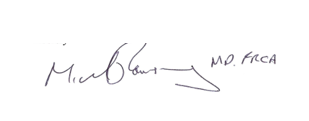
Michael A.E. Ramsay, MD, FRCA, Chief Executive Officer, PSMF
August Is Psoriasis Awareness Month
Over eight million people in this country and 125 million worldwide live with psoriasis. Each August, Psoriasis Awareness Month presents an important opportunity to raise awareness and educate sufferers and the healthcare community on treatments, triggers, and management techniques for the inflammatory skin disease.
Psoriasis can affect anyone regardless of gender, age, and race, and manifests differently for each person on a variety of body parts (knees, elbows, scalp, and torso, most commonly) as an itchy scaly rash. Painful flareups, which tend to occur in cycles, can interfere with sleep and make it difficult to concentrate, work, and relax. Its exact cause is still unknown, but specialists believe it is related to the immune system and genetics. Common triggers include infections, skin injuries, alcohol consumption, vitamin D deficiency, stress, emotional trauma, certain medications, and smoking.
Fortunately, the disease can be controlled and treated through a variety of means. Which treatments are used depends on the severity and responsiveness to previous treatments and self-care measures. Different drugs or a combination of treatments may be needed before finding an approach that works. As there currently is no permanent cure, psoriasis flareups usually return.
Chairman’s Column
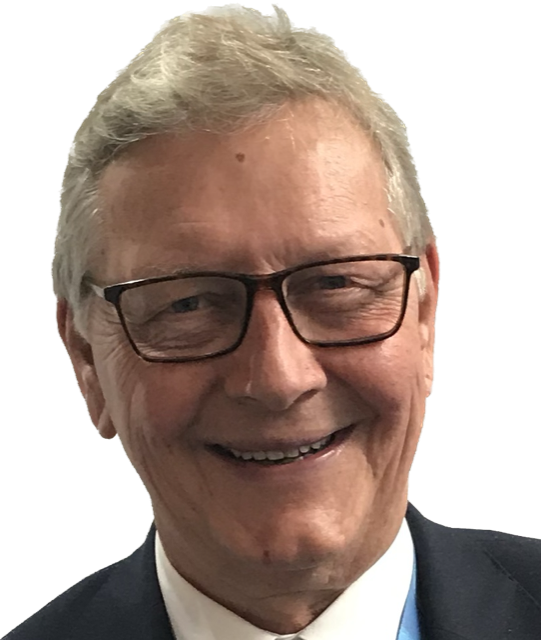
Dear Friends:
We have much to look forward to as we swing back into action after a vacation break that has demonstrated in every continent the need to accept that our climate has changed and will continue to raise questions for us to answer in a truly multimodal paradigm to manage our rising seas and temperatures.
In particular, later next month on World Patient Safety Day, we will recognize the importance of engaging patients for patient safety. Events will take place across the globe where we demonstrate solidarity in our efforts by highlighting hundreds if not thousands of national, civic, and healthcare buildings with the color orange.
I have included here a snapshot from Dr. Neelam Dhingra, whom many of you know as the powerhouse behind WHO’s efforts to conceive and deliver the Global Patient Safety Action Plan as well as to orchestrate the events taking place on and around September 17, 2023. I know that we, as the Patient Safety Movement Foundation, will be led in this endeavor by Mike Ramsay, along with many others in Washington, DC, as many of us elsewhere will be flying the flag in different parts of the world.
As Dr. Dhingra identifies, “The campaign website includes the campaign objectives, target audiences, key messages, calls to action, advice to stakeholders, relevant resources, and survey link to share your plans for commemorating WPSD 2023. The communication products can be found under ‘Campaign essentials’ and currently include:
- The WPSD Logos in the six UN languages (English, Arabic, Chinese, French, Spanish, and Russian).
- Part of the communication assets in English (poster, web banners, roll-up banner, social media sticker, meeting backdrop, screen saver, selfie frame, souvenirs’ designs).
Our team is working diligently to make additional communication assets available, including for social media. We request you please visit the website regularly for updates.”
As she notes, “We are all looking forward to an outstanding global celebration of this momentous occasion with your full participation and our strengthened collaboration.”
We have had a bad time this last week affecting the NHS in England, as the case of Lucy Letby, a neonatal nurse in Chester, was concluded. She was found guilty of the murder of seven babies and the attempts to kill six other babies between June 2015 and June 2016.
https://www.bmj.com/content/382/bmj.p1943
While we wait for further inquiries into the circumstances that allowed such appalling acts to take place, there is already much debate as to the actions taken at the time when staff tried to raise concerns about Letby with the management and executives at the hospital. It appears these concerns were not taken seriously, that hospital management was fearful of reputational damage, and that those doctors raising concerns were seen to be acting inappropriately and possibly warranting a poor conduct referral to the General Medical Council.
The question has now, and not for the first time, been raised as to whether health managers and executives in the NHS should also be regulated to the same degree as doctors, nurses, and other healthcare practitioners. This is a question for us all to consider, as we know that systems and processes alone are not the answer to ensuring a high-quality system with safeguards to reduce harm, intentional or not.
We know that we need a whole system approach that ensures a human-factors and ergonomic understanding, that an appropriate safety culture within and between the teams is essential, and that most of all, we need to create a compact between us all that allows for transparency, honesty, and respect for each other.
This triad of ethical values must also be seen as the way we work at all times, and as much as possible, the hierarchy that so often precludes effective and honest dialogue when things are not quite right needs to be broken down.
All members of the team are important, no matter their level of expertise. They should all be allowed to speak up without fear when they recognize that an action or a behavior is not correct or in the best interests of the patient.
We are here to serve our patients and their families who have entrusted us to support them when they need care and effective treatment. We owe it to them to work as effectively as a team as possible, to share information in a transparent and candid manner, and to act with urgency when we recognize signals that identify potential or actual harm.
Yours,

Mike Durkin, OBE, MBBS, FRCA, FRCP, DSC
Innovation Corner*
Flexible Acuity: Enhancing Patient Safety with Adaptive Care Solutions
Patient acuity can change rapidly, and healthcare professionals continuously assess and adjust care accordingly to meet their evolving medical needs. This adaptability is crucial for safe and effective healthcare, ensuring patients receive appropriate attention. GE Healthcare’s unified monitoring solution adapts to every patient need at every point of care, helping to improve clinical outcomes and support care decisions for enhanced patient safety.

*Patient Safety Movement Foundation does not endorse any specific commercial products, services, or companies. Information included in this section is merely to share the technologies that may improve patient safety.
In the News
- The US Department of Health and Human Services, Office of Inspector General just released two Adverse Events Toolkits: one detailing a “Medical Record Review Methodology” and the other offering “Clinical Guidance for Identifying Patient Harm.”
- US News reported on the recent Johns Hopkins Medicine study that revealed that 795,000 Americans die or are permanently disabled every year due to misdiagnosed medical conditions.
- Calls for a National Patient Safety Board are increasing, as three healthcare leaders share their thoughts with Becker’s Hospital Review.
- The Joint Commission issued recommendations for health systems in the event of a cyberattack, stressing the entire health system be included in preparations, as reported by healthleadermedia.com.
- Pharmacy Times published an article on how new pharmacy standards could drive changes that improve patient safety by optimizing drug therapy to reduce the risk of harm and improve health and well-being before a medication is dispensed.
- A Texas court ruled in favor of women harmed by the state’s abortion ban’s inadequate protection for medical emergencies, as reported by Justia.
- An article by Medscape examined the public health versus patient safety dilemma posed by the use of ethylene oxide, as emissions from sterilization plants have been linked to an increased risk of cancer.
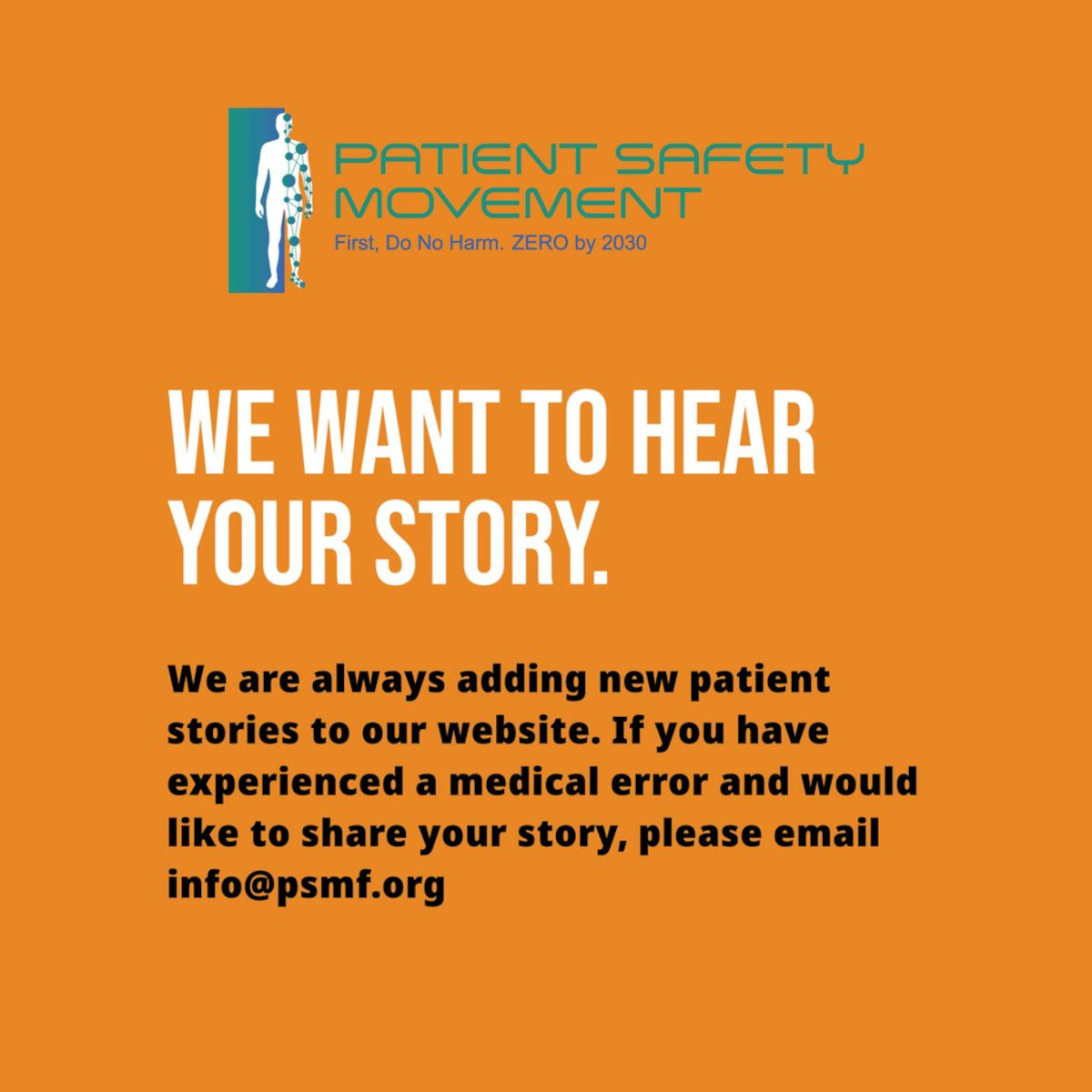
DONOR TESTIMONIALS — WHY I GIVE

Why is patient safety important to me?
I began my career in health care as part of the leadership team of a pediatric specialty hospital in my home state of Maryland. There, I saw firsthand the importance of safe, quality care and what a difference it made in the lives of our patients and their families—and I saw the pride of staff when our patients were discharged in better condition than when they arrived. I and family members,
like everyone else, have accessed our health care system. With but a few minor exceptions, our experiences have been positive. We were fortunate, though not all are.
I am extremely grateful to those nurses, doctors, and other caregivers that took the time and have the commitment and dedication to “getting things right.”
There are too many instances where things have gone wrong—with devastating results. I hear these stories all too often and know all too well the crushing effects of medical harm. No one should have to endure the loss of a loved one or a catastrophic condition due to a preventable situation. I have met many patients and families who wear the scars—literally and figuratively—of medical harm. Their stories are beyond tragic, and if you ever hear even one, you will forever be affected. We cannot allow one more tragedy; we cannot allow one more mother to lose a child. The grim parade of heartbreak due to medical harm must end.
That is why patient safety is important to me.
Robert H. Imhoff III
President
Hospital Quality Institute / A division of the California Hospital Association
GOVERNANCE BOARD
Mike Durkin, OBE, MBBS, FRCA, FRCP, DSC, Chairman of PSMF, Senior advisor on Patient Safety Policy and Leadership, Institute of Global Health Innovation, Imperial College London
Steven J. Barker, PhD, MD, Chief Science Officer, Masimo Corporation, Professor Emeritus of Anesthesiology, University of Arizona Health Sciences
Robin Betts, RN, CPHQ, MBA-HA, Vice Chair, PSMF, Vice President, Safety Quality & Regulatory Services, Kaiser Foundation Hospitals and Health Plan, Kaiser Permanente Northern California
Alicia Cole, Patient Safety Consultant
Javier T. Davila, MD, MFS, Ambassador, PSMF in Mexico, Former Medical Director, Mexican Social Security Institute, Head of Medical Education, Research and Health Public Policy
Omar Ishrak, PhD, Executive Chairman and Chairman of the Board of Directors, Medtronic, Chairman of the Board of Directors, Intel
Philip D. Lumb, MB, BS, MD, MCCM, FCCP, Professor of Anesthesiology and Trauma Surgery, Keck School of Medicine at University of Southern California
Joe Kiani, Founder and Immediate Past Chairman of PSMF, Founder, Chairman & CEO of Masimo
Sarah Kiani, Director, Masimo Foundation for Ethics, Innovation, and Competition
David B. Mayer, MD, Executive Director, MedStar Institute for Quality and Safety
Jannicke Mellin-Olsen, MD, DPH, Past President, World Federation of Societies of Anesthesiologists
Jim Messina, CEO, The Messina Group
Najmedin Meshkati, Ph.D, MS, Professor of Civil/Environmental Engineering, University of Southern California
Charlie Miceli, CPM, Treasurer, PSMF, Chief Supply Chain Officer, Network VP of University of Vermont Health Network
Michael A.E. Ramsay, MD, FRCA, Chief Executive Officer, PSMF
Abbasseh Towfigh, MPD, Executive Director and Secretary, Ayeneh Foundation
Vonda Vaden Bates, Patient Advocate, CEO, 10th Dot
OUR STORY
 In 2012, Joe Kiani founded the nonprofit Patient Safety Movement Foundation (PSMF) to eliminate preventable medical errors in hospitals. His team worked with patient safety experts from around the world to create Actionable Evidence-Based Practices (AEBP) that address the top challenges. The AEBP is available without charge to hospitals online.
In 2012, Joe Kiani founded the nonprofit Patient Safety Movement Foundation (PSMF) to eliminate preventable medical errors in hospitals. His team worked with patient safety experts from around the world to create Actionable Evidence-Based Practices (AEBP) that address the top challenges. The AEBP is available without charge to hospitals online.
Hospitals are encouraged to make a formal commitment to ZERO preventable deaths, and healthcare technology companies are asked to sign the Open Data Pledge to share their data so that predictive algorithms that can identify errors before they become fatal can be developed. The Foundation’s annual World Patient Safety, Science & Technology Summit brings together all stakeholders, including patients, healthcare providers, medical technology companies, government employers, and private payers. The PSMF was established through the support of the Masimo Foundation for Ethics, Innovation, and Competition in Healthcare. For more information, please visit psmf.org.

